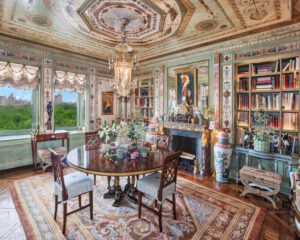
A Diamond Legacy in Stone and Brick
For decades, the name Harry Winston has been synonymous with luxury, precision, and an unmatched eye for beauty. Known as the “King of Diamonds,” Winston shaped the world of fine jewelry with bold acquisitions and designs that adorned royalty, celebrities, and icons. Yet beyond the sparkle of rare gems and red-carpet appearances lies a lesser-known but equally fascinating facet of his legacy: his stunning residence on the Upper East Side. This piece of Manhattan real estate, Winston’s home for 26 years, recently sold for $24.5 million, a transaction that underscores not only its architectural magnificence but also its historical significance.
Spanning an impressive 5,700 square feet in a storied Upper East Side co-op building, the apartment has been a fixture of quiet elegance since Winston’s era. Its sale marks the end of a chapter that began in the 1950s, when Winston’s vision extended beyond diamonds and into the art of refined living. This editorial explores the intricate history of Winston’s residence, its cultural significance, and the ongoing allure of Manhattan’s Upper East Side as the epicenter of opulence.
The Upper East Side: A Backdrop of Prestige
The Upper East Side has long been a symbol of old-money sophistication and high-society exclusivity. During Harry Winston’s time, the neighborhood embodied the pinnacle of New York wealth, its grand limestone buildings housing the crème de la crème of industry magnates, artists, and cultural icons.
Winston’s co-op apartment was part of an early 20th-century prewar building, known for its ornate design, expansive layouts, and curated community. These buildings, often designed by Rosario Candela and his contemporaries, represented the height of architectural ambition: vast proportions, intricate moldings, and interiors tailored for both beauty and utility. Winston’s home exemplified these qualities with its five bedrooms, six bathrooms, and expansive entertaining spaces. The apartment’s size alone is a rare commodity in modern Manhattan, where square footage is often a battle fought by even the wealthiest.
In purchasing this residence, Winston not only joined the ranks of New York’s elite but also cemented his taste for permanence and understated grandeur, a departure from the fleeting glamour of his diamond trade.
Harry Winston: The Visionary Behind the Residence
Harry Winston’s professional story is one of ambition, instinct, and an intimate understanding of artistry. Born in 1896 to immigrant parents, Winston’s fascination with jewels began young—by 12, he had already identified a two-carat emerald in a pawnshop window and sold it for a handsome profit. His legendary career saw him procure and transform some of the most famous diamonds in history, including the Hope Diamond and the Jonker Diamond, reshaping them into breathtaking new forms.
By the 1950s, Winston’s growing influence brought him not just wealth but global renown. He settled into his Upper East Side residence, a place that matched his professional ethos: timeless, carefully curated, and commanding in its presence. The apartment was as much a part of his legacy as the jewels he meticulously set—solid, valuable, and irreplaceable.
Winston entertained New York’s elite here, though the space retained a quiet sense of privacy, far from the flamboyance of his public persona. For him, this residence reflected the sophistication of an era where luxury was defined not by excess, but by attention to detail and craftsmanship.
The Residence: An Inside Look at Elegance
To understand the magnitude of Winston’s home is to appreciate the art of prewar Manhattan design. The 5,700-square-foot layout is emblematic of the Gilded Age influence:
•Grand Entertaining Rooms: The apartment features a formal dining room capable of hosting dignitaries and high-profile clientele—a perfect fit for a man whose business catered to kings and queens.
•Expansive Living Spaces: A massive living room, adorned with classic moldings, large windows, and high ceilings, speaks to a timeless elegance. These rooms were likely where Winston himself spent time conceptualizing designs, reviewing stones, and escaping the high-pressure world of commerce.
•Private Quarters: Five large bedrooms provide a personal, almost quiet retreat from the buzz of the city. Each room likely reflected Winston’s appreciation for bespoke luxury, with custom detailing to match the unique demands of New York’s elite.
•Modernized Comforts: Despite its historical roots, the apartment has undergone renovations to meet modern expectations of functionality, particularly in the kitchen and bathrooms, balancing old-world charm with contemporary living standards.
Over the decades, its blend of original design and modern updates has maintained the property’s appeal, contributing to its recent sale at an impressive price point.
A Market Story: The Journey to $24.5 Million
The sale of Harry Winston’s former apartment was not an overnight affair. The property has been on and off the market since 2019, a reflection of Manhattan’s ever-changing luxury real estate market. The co-op system, which imposes strict vetting processes for prospective buyers, often slows transactions for properties of this caliber.
Initially listed at a higher asking price, the $24.5 million final sale represents the resilience of trophy properties in New York real estate. For ultra-wealthy buyers, homes like Winston’s are not just places to live—they are historical artifacts and symbols of achievement. The apartment’s provenance as Harry Winston’s residence adds an intangible value that only increases its desirability.
Manhattan’s luxury market has faced its share of fluctuations over the past few years, with factors like economic shifts, interest rates, and global buyer activity shaping demand. Yet Winston’s residence transcends market conditions. As with fine diamonds, properties with a rich legacy retain their luster, attracting buyers who understand the weight of history.
The Legacy Lives On: A New Chapter for a Storied Space
The recent sale of Harry Winston’s Upper East Side apartment marks the continuation of its storied existence. While the buyer’s identity remains undisclosed, they inherit more than just a luxurious space; they become stewards of a legacy. The walls of this apartment have borne witness to the life of one of the world’s most renowned jewelers—a man whose name still commands reverence.
For fans of architecture and history, Winston’s residence stands as a microcosm of Manhattan’s cultural evolution. The Upper East Side continues to attract those who seek permanence and prestige in an increasingly transient world. Properties like Winston’s apartment remind us that luxury is not fleeting—it is enduring, as timeless as the diamonds he once shaped.
Harry Winston’s Lasting Influence
Harry Winston’s life was defined by his ability to see beauty where others could not: in rough stones waiting to be cut, in designs waiting to be imagined, and in spaces waiting to be transformed. His former Upper East Side apartment, now sold for $24.5 million, mirrors this sensibility.
The sale is more than a transaction; it is a testament to the enduring value of craftsmanship, history, and vision. Just as Winston revolutionized the world of fine jewelry, his home represents a lasting piece of New York’s architectural and cultural heritage—a reminder that true luxury, like diamonds, is forever.
No comments yet.








